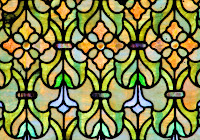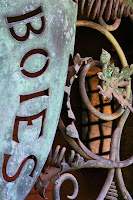I guess those of us living in the northeastern part of the U.S. get to enjoy a unique aspect of our cemeteries that people in other parts of the country cannot – the rainbow of colors brought on by leaves changing colors in the fall. (I have this ridiculous notion that you can never see Minnesotan cemeteries because the ground is always covered with snow!). If you happen to pair up the fall foliage extravaganza with a truly beautiful cemetery, the result can be breathtaking. I experienced this at the beginning of November at the Dunmore Cemetery in Dunmore, Pennsylvania.
Dunmore is in the northeastern part of PA, an old coal mining region, two miles north of Scranton (made famous on the TV show “The Office”). The reason I was in Scranton was because I was invited to participate as an artist in Scranton’s First Friday Arts Walk. Most cities have them – once a month, galleries change their exhibits, stay open late, and offer free wine and cheese doodles. Sometimes other businesses get involved, hanging artwork, hosting live bands, etc. You see bookstores, restaurants, bars, ever even churches participating. The good people at St. Luke’s Episcopal Church in Scranton were my hosts for the evening.
 Prior to arriving at the church, I spent a few hours photographing in the Dunmore Cemetery, at the recommendation of the two fine people who were responsible for my being invited − Julie Esty and Wendy Belaski, members of the Dunmore Cemetery’s “Dearly Departed Players” theatrical group. This group offers a stone by stone walk though the history of the residents of the cemetery (sponsored by the Lackawana Historical Society).
Prior to arriving at the church, I spent a few hours photographing in the Dunmore Cemetery, at the recommendation of the two fine people who were responsible for my being invited − Julie Esty and Wendy Belaski, members of the Dunmore Cemetery’s “Dearly Departed Players” theatrical group. This group offers a stone by stone walk though the history of the residents of the cemetery (sponsored by the Lackawana Historical Society).Established in 1828, Dunmore Cemetery offers unique and well-preserved ironwork, headstones, statuary, and mausoleums. Across its hilly 35 acres, you'll see a pyramid, a lovely chapel, ornate crypts, even a zinc memorial thrown in for good measure – all blending art with the preservation of memories. Many memorials are quite unique, e.g. the castle-like crypt of the Boies family - with its filigree metalwork inside the entrance. its every bit as extravagant as anything you'd see in Paris' Pere Lachaise Cemetery.
 |
| Boies Mausoleum, Dunmore Cemetery |
 |
| Julie Esty's book |
As cemeteries revitalize and try to earn more money to stay in business, a major thrust is to get more live people to spend time in them. Why would that matter? Well, if you can offer novel and interesting attractions to people (such that they’ll pay money to come to the cemetery), you can generate income from:
- · Historic tours
- · Concerts
- · Beer tastings (!)
- · Special events such as Halloween parties and presentations
 But there’s a subtle yet very important reason to attract people to cemeteries, which Julie and Wendy pointed out to me later that evening − the more people who are around, the less likely vandals and thieves will be to damage and steal. As the founder and artistic director of the Dearly Departed Players, Julie Esty has figured out a way to get people into a cemetery (live people, i.e.). Over the course of two Sundays this past October, her two-hour tours of the Dunmore Cemetery drew eight hundred people! She is quite passionate about what her group does in this very popular form of historic preservation (there is actually no fee for the tour).
But there’s a subtle yet very important reason to attract people to cemeteries, which Julie and Wendy pointed out to me later that evening − the more people who are around, the less likely vandals and thieves will be to damage and steal. As the founder and artistic director of the Dearly Departed Players, Julie Esty has figured out a way to get people into a cemetery (live people, i.e.). Over the course of two Sundays this past October, her two-hour tours of the Dunmore Cemetery drew eight hundred people! She is quite passionate about what her group does in this very popular form of historic preservation (there is actually no fee for the tour). |
| Photo by Tim Snyder |
 |
| Wendy Belaski, Ed Snyder, and Julie Esty |
 |
| Stained glass from Dunmore mausoleum |
Julie Esty and Wendy Belaski (who specializes in the art of mausoleum stained glass), arrived in Victorian hoop dresses and bonnets, as they were exhibiting pieces of funeral history, including post-mortem photographs, mourning clothing, and other artifacts. They’re as much into dead things as I am, so we hit it off well. I appreciate all the tips on nearby cemeteries to visit (especially the run down and nearly abandoned ones) and will definitely head back to Scranton soon. All in all, it was a fabulous visit, and I thank everyone for their hospitality!
References and Further Listening and Reading:
Stories in Stone – Tales of Life from the Dunmore Cemetery, by Julie Snell-Esty, 2010
Hear Julie Esty’s podcast interview on the Dunmore Cemetery (hear what goes into planning a historical cemetery tour!)






